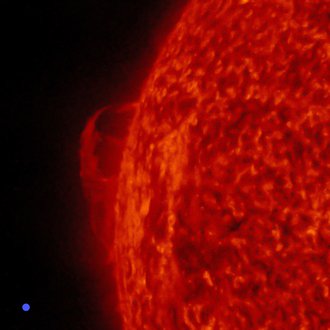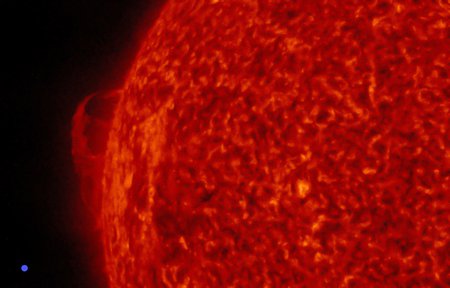How the Sun’s magnetic forces arrange gas particles

The solar prominence from 28 June 2019, 7:58 a.m., observed by the Solar Dynamics Observatory (SDO). For size comparison, the Earth is shown as a small blue circle in the lower left corner.
Credit: NASA/SDO and the AIA, EVE, and HMI science team; Edit: AIPA research team including the Leibniz Institute for Astrophysics Potsdam (AIP) has investigated a solar prominence and has observed that charged particles in it moved 70 percent faster than uncharged particles. The measurements hint at the dynamical processes in the prominence and can be used, for example, to check model computations for simulating gas clouds in star and planet formation.
On the surface of the Sun, arc-shaped streams of matter can form, and float like giant clouds above the visible solar disk. Such prominences are held by a supporting framework of magnetic field lines, originating from layers deep within the Sun. The ever-present gas currents move the supporting framework and, with it, the prominence cloud. A team made up of researchers from the universities of Göttingen, Paris, and Locarno, as well as from AIP, have observed that charged ions in these prominences were up to 70 per cent faster than neutral atoms. The results of the study have been published in The Astrophysical Journal.
The researchers observed how magnetic forces lifted a prominence by 25,000 kilometres – about two times the diameter of the Earth – within ten minutes. This uplift corresponds to a speed of 42 kilometres per second, which is about four times the speed of sound in the prominence. Oscillations occurred with a period of 22 seconds, during which time the positively charged ions of iron were up to 70 per cent faster than neutral helium atoms. According to the laws of physics, the charged iron ions must follow the movement of the magnetic field but the uncharged helium atoms are not affected in the same way. In fact, the helium atoms are carried only partly along by the ions, as there are not enough collisions between the two types of particles due to the low gas pressure. Dr Horst Balthasar from AIP remarks: “These short period oscillations show how dynamic the physical processes within the prominence are.”
Such conditions – where partially ionised gas exists with few collisions – play an important role, not only in solar prominences, but also in the huge gas clouds from which stars and planets form, in the gas that fills the vast expanse between stars, and in the gas between galaxies. Theoretical astrophysicists have already simulated such conditions with two fluids interacting only weakly with each other. “Some of the previous assumptions used in model calculations can now be verified thanks to these new measurements in our results,” explains Dr Eberhard Wiehr from the Institute for Astrophysics at the University of Göttingen, first author of the study.
The team carried out the observations at the solar telescope in Locarno, where it is only possible to measure two emission lines simultaneously. Now the scientists are planning extended observations at the French telescope on Tenerife, where several lines can be measured at the same time. In addition, the better light-sensitivity of the telescope will enable the measurement of even shorter oscillation periods. AIP is preparing a new camera system for the spectrograph of the German Vacuum Tower Telescope (VTT) on Tenerife, which will also allow simultaneous observations of several spectral lines. “We may then find even higher velocity differences between the charged ions and the neutral atoms,” adds Eberhard Wiehr.
Further information
Original publication
Eberhard Wiehr et al. Velocity difference of ions and neutrals in solar prominences. Astrophysical Journal (2021).
DOI: https://doi.org/10.3847/1538-4357/ac1791
https://arxiv.org/abs/2108.13103
University of Göttingen press release
Images
The solar prominence from 28 June 2019, 7:58 a.m., observed by the Solar Dynamics Observatory (SDO). For size comparison, the Earth is shown as a small blue circle in the lower left corner.
Big screen size [1000 x 640, 80 KB]
Original size [2009 x 1286, 230 KB]



